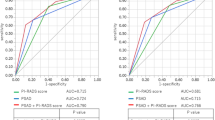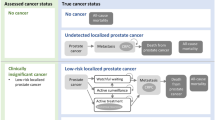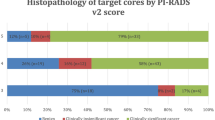Abstract
Purpose
Multiparametric magnetic resonance imaging (mpMRI) improves clinically significant prostate cancer (csPCa) detection by facilitating targeted biopsy (cognitive, fusion technology, or in-gantry MRI guidance) and reducing negative biopsies. This study sought to describe the feasibility of introducing an mpMRI-based triage pathway, including diagnostic performance, applicability to training, and cost analysis.
Methods
An observational retrospective cohort study of consecutive patients attending a large public tertiary referral training hospital who underwent mpMRI for suspicion of prostate cancer was considered. Standard clinical, MRI-related, histopathological, and financial parameters were collected for analysis of biopsy avoidance, diagnostic accuracy of biopsy approach, and operator (consultant and resident/registrar) and logistical (including financial) feasibility.
Results
653 men underwent mpMRI, of which 344 underwent prostate biopsy resulting in a 47% biopsy avoidance rate. Overall, 240 (69.8%) patients were diagnosed with PCa, of which 208 (60.5%) were clinically significant, with higher rates of csPCa observed for higher PIRADS scores. In patients who underwent both systematic and targeted biopsy (stTPB), targeted cores detected csPCa in 12.7% and 16.6% in more men than systematic cores in PIRADS 5 and 4, respectively, whereas systematic cores detected csPCa in 5% and 3.2% of patients, where targeted cores did not. A high standard of performance was maintained across the study period and the approach was shown to be cost effective.
Conclusions
Introdution of an mpMRI-based triage system into a large public tertiary teaching hospital is feasible, cost effective and leads to high rates of prostate cancer diagnosis while reducing unnecessary biopsies and detection of insignificant PCa.
Similar content being viewed by others
References
Mottet N, Bellmunt J, Bolla M, Briers E, Cumberbatch MG, De Santis M et al (2017) EAU-ESTRO-SIOG guidelines on prostate cancer. Part 1: screening, diagnosis, and local treatment with curative intent. Eur Urol 71(4):618–629
Taira AV, Merrick GS, Galbreath RW, Andreini H, Taubenslag W, Curtis R et al (2010) Performance of transperineal template-guided mapping biopsy in detecting prostate cancer in the initial and repeat biopsy setting. Prostate Cancer Prostatic Dis 13(1):71–77
Moldovan PC, Van den Broeck T, Sylvester R, Marconi L, Bellmunt J, van den Bergh RCN et al (2017) What is the negative predictive value of multiparametric magnetic resonance imaging in excluding prostate cancer at biopsy? A systematic review and meta-analysis from the European association of urology prostate cancer guidelines panel. Eur Urol 72(2):250–266
Pokorny MR, de Rooij M, Duncan E, Schroder FH, Parkinson R, Barentsz JO et al (2014) Prospective study of diagnostic accuracy comparing prostate cancer detection by transrectal ultrasound-guided biopsy versus magnetic resonance (MR) imaging with subsequent MR-guided biopsy in men without previous prostate biopsies. Eur Urol 66(1):22–29
Ahmed HU, El-Shater Bosaily A, Brown LC, Gabe R, Kaplan R, Parmar MK et al (2017) Diagnostic accuracy of multi-parametric MRI and TRUS biopsy in prostate cancer (PROMIS): a paired validating confirmatory study. Lancet 389(10071):815–822
Kasivisvanathan V, Rannikko AS, Borghi M, Panebianco V, Mynderse LA, Vaarala MH et al (2018) MRI-targeted or standard biopsy for prostate-cancer diagnosis. N Engl J Med 378(19):1767–1777
Loch R, Fowler K, Schmidt R, Ippolito J, Siegel C, Narra V (2015) Prostate magnetic resonance imaging: challenges of implementation. Curr Probl Diagn Radiol 44(1):26–37
Brizmohun Appayya M, Adshead J, Ahmed HU, Allen C, Bainbridge A, Barrett T et al (2018) National implementation of multi-parametric magnetic resonance imaging for prostate cancer detection—recommendations from a UK consensus meeting. BJU Int 122(1):13–25
Rosenkrantz AB, Verma S, Choyke P, Eberhardt SC, Eggener SE, Gaitonde K et al (2016) Prostate magnetic resonance imaging and magnetic resonance imaging targeted biopsy in patients with a prior negative biopsy: a consensus statement by AUA and SAR. J Urol 196(6):1613–1618
de Rooij M, Crienen S, Witjes JA, Barentsz JO, Rovers MM, Grutters JP (2014) Cost-effectiveness of magnetic resonance (MR) imaging and MR-guided targeted biopsy versus systematic transrectal ultrasound-guided biopsy in diagnosing prostate cancer: a modelling study from a health care perspective. Eur Urol 66(3):430–436
Bennett HY, Roberts MJ, Doi SA, Gardiner RA (2016) The global burden of major infectious complications following prostate biopsy. Epidemiol Infect 144(8):1784–1791
Roberts MJ, Parambi A, Barrett L, Hadway P, Gardiner RA, Hajkowicz KM et al (2013) Multifocal abscesses due to multiresistant Escherichia coli after transrectal ultrasound-guided prostate biopsy. Med J Aust 198(5):282–284
Roberts MJ, Bennett HY, Harris PN, Holmes M, Grummet J, Naber K, Wagenlehner FME (2017) Prostate biopsy-related infection: a systematic review of risk factors, prevention strategies, and management approaches. Urology 104:11–21
Gordon LG, James R, Tuffaha HW, Lowe A, Yaxley J (2017) Cost-effectiveness analysis of multiparametric MRI with increased active surveillance for low-risk prostate cancer in Australia. J Magn Reson Imaging 45(5):1304–1315
Yaxley AJ, Yaxley JW, Thangasamy IA, Ballard E, Pokorny MR (2017) Comparison between target magnetic resonance imaging (MRI) in-gantry and cognitively directed transperineal or transrectal-guided prostate biopsies for Prostate Imaging-Reporting and Data System (PI-RADS) 3–5 MRI lesions. BJU Int 120(Suppl 3):43–50
Barentsz JO, Richenberg J, Clements R, Choyke P, Verma S, Villeirs G et al (2012) ESUR prostate MR guidelines 2012. Eur Radiol 22(4):746–757
Epstein JI, Egevad L, Amin MB, Delahunt B, Srigley JR, Humphrey PA (2016) The 2014 International Society of Urological Pathology (ISUP) Consensus Conference on gleason grading of prostatic carcinoma: definition of grading patterns and proposal for a new grading system. Am J Surg Pathol 40(2):244–252
Futterer JJ, Briganti A, De Visschere P, Emberton M, Giannarini G, Kirkham A et al (2015) Can clinically significant prostate cancer be detected with multiparametric magnetic resonance imaging? A systematic review of the literature. Eur Urol 68(6):1045–1053
MacAskill F, Lee S-M, Eldred-Evans D, Wulaningsih W, Popert R, Wolfe K et al (2017) Diagnostic value of MRI-based PSA density in predicting transperineal sector-guided prostate biopsy outcomes. Int Urol Nephrol 49(8):1335–1342
Distler FA, Radtke JP, Bonekamp D, Kesch C, Schlemmer H-P, Wieczorek K et al (2017) The value of PSA density in combination with PI-RADS™ for the accuracy of prostate cancer prediction. J Urol 198(3):575–582
Felker ER, Raman SS, Margolis DJ, Lu DSK, Shaheen N, Natarajan S et al (2017) Risk stratification among men with prostate imaging reporting and data system version 2 category 3 transition zone lesions: is biopsy always necessary? AJR Am J Roentgenol 209(6):1272
Wegelin O, van Melick HHE, Hooft L, Bosch J, Reitsma HB, Barentsz JO et al (2017) Comparing three different techniques for magnetic resonance imaging-targeted prostate biopsies: a systematic review of in-bore versus magnetic resonance imaging-transrectal ultrasound fusion versus cognitive registration. Is there a preferred technique? Eur Urol 71(4):517–531
Gayet M, van der Aa A, Beerlage HP, Schrier BP, Mulders PF, Wijkstra H (2016) The value of magnetic resonance imaging and ultrasonography (MRI/US)-fusion biopsy platforms in prostate cancer detection: a systematic review. BJU Int 117(3):392–400
Westhoff N, Haumann H, Kriegmair MC, von Hardenberg J, Budjan J, Porubsky S, et al. Association of training level and outcome of software-based image fusion-guided targeted prostate biopsies. World J Urol 2018 (in press)
Borofsky S, George AK, Gaur S, Bernardo M, Greer MD, Mertan FV et al (2018) What are we missing? False-negative cancers at multiparametric MR imaging of the prostate. Radiology 286(1):186–195
Le JD, Tan N, Shkolyar E, Lu DY, Kwan L, Marks LS et al (2015) Multifocality and prostate cancer detection by multiparametric magnetic resonance imaging: correlation with whole-mount histopathology. Eur Urol 67(3):569–576
Donato P, Roberts MJ, Morton A, Kyle S, Coughlin G, Esler R et al (2019) Improved specificity with (68)Ga PSMA PET/CT to detect clinically significant lesions "invisible" on multiparametric MRI of the prostate: a single institution comparative analysis with radical prostatectomy histology. Eur J Nucl Med Mol Imaging 46(1):20–30
Truong M, Miyamoto H, Weinberg E, Hollenberg G, Messing E, Frye T (2017) Impact of gleason pattern 4 cribriform architecture on prostate cancer detection using multiparametric MRI. J Urol 197(4):E210
Priester A, Natarajan S, Khoshnoodi P, Margolis DJ, Raman SS, Reiter RE et al (2017) Magnetic resonance imaging underestimation of prostate cancer geometry: use of patient specific molds to correlate images with whole mount pathology. J Urol 197(2):320–326
Faria R, Soares MO, Spackman E, Ahmed HU, Brown LC, Kaplan R et al (2018) Optimising the diagnosis of prostate cancer in the era of multiparametric magnetic resonance imaging: a cost-effectiveness analysis based on the prostate MR imaging study (PROMIS). Eur Urol 73(1):23–30
Acknowledgements
Sachinka Ranasinghe for assistance with data collection.
Funding
None.
Author information
Authors and Affiliations
Contributions
PD: protocol development, data collection, management and analysis, and manuscript writing. AM: data collection and management. JY: protocol/project development and manuscript editing. PET: data management and manuscript editing. GC: protocol/project development and manuscript editing. RE: protocol/project development and manuscript editing. ND: protocol/project development and manuscript editing. RAG: protocol/project development and manuscript editing. MJR: protocol/project development, data management and analysis, and manuscript writing and editing.
Corresponding author
Ethics declarations
Conflict of interest
Nil to declare.
Research involving Human participants and/or animals
Per institutional ethics board approval.
Informed consent
Per institutional ethics board approval.
Additional information
Publisher's Note
Springer Nature remains neutral with regard to jurisdictional claims in published maps and institutional affiliations.
Electronic supplementary material
Below is the link to the electronic supplementary material.
Rights and permissions
About this article
Cite this article
Donato, P., Morton, A., Yaxley, J. et al. Improved detection and reduced biopsies: the effect of a multiparametric magnetic resonance imaging-based triage prostate cancer pathway in a public teaching hospital. World J Urol 38, 371–379 (2020). https://doi.org/10.1007/s00345-019-02774-y
Received:
Accepted:
Published:
Issue Date:
DOI: https://doi.org/10.1007/s00345-019-02774-y




